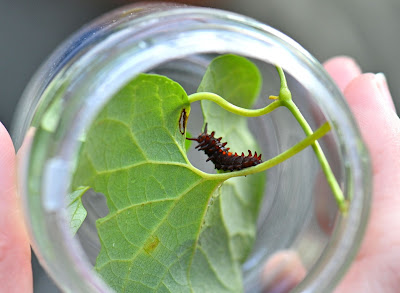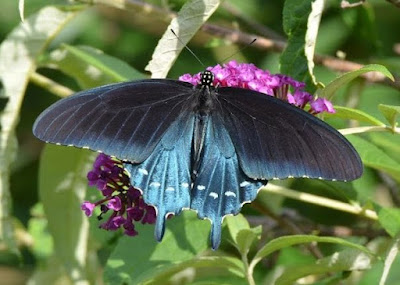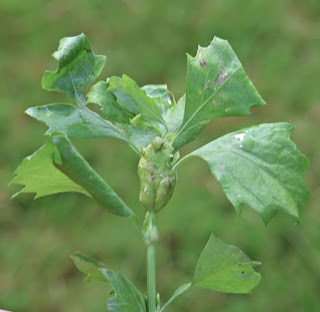Leader for today's Ramble: Heather
Authors of
today’s report: Heather and Linda
Insect, gall, and plant identifications: Don Hunter, Heather Larkin, Dale Hoyt, Linda Chafin
Link to Don’s Facebook album for this Ramble. All the photos that appear in this report, unless otherwise credited, were taken by Don Hunter.
Number of Ramblers today: 30
Show and Tell: Gary brought an Elderberry twig and recommended planting it in floodplains after removing Chinese Privet. Elderberry twigs will root if you just stick them into wet soil in late winter – a technique called “live staking.” It’s a great wildlife species: the large flower clusters attract butterflies and other pollinating insects, and the berries are eaten by as many as 45 bird species. The leaves are also eaten by the caterpillar of the Cecropia moth, North American’s largest moth. Kathy mentioned that various plant purveyors are marketing selections from wild examples that have many more and much larger berries. It’s an easy plant to grow, with hers doing well and growing to large size.
 |
| Elderberry leaf and fruit |
 |
| Myrna brought a tiny Pipevine Swallowtail
butterfly caterpillar. |
 |
Pipevine Swallowtai adult (photo by Sandy Shaull) |
Pipevine Swallowtail caterpillars eat only the leaves of Dutchman's Pipevine and its close relatives in the Birthwort Family. As they eat the leaves, the caterpillars acquire a toxic plant compound – aristolochic acid – to which they are immune, and then pass it on to the adult form of the butterfly. The acid is then passed along by the females to their eggs. Birds quickly learn to recognize and avoid all stages in the species' life cycle: the red-spotted caterpillars, the bright blue and black adults, and the red eggs. Several other swallowtails, as well as the Red-spotted Purple butterfly, have evolved similar coloration, a form of mimicry that provides some protection from predators.
Announcements/Interesting Things to Note:
Reminder: the new versions of Rambler t-shirts
(and a hoodie!) are on sale at the Satisfactory Printing website. Two of the shirts are cut for women and the other two are unisex. Note that the hoodie is a jacket with a zipper. The sale will end on August 13.
You will have the choice of paying for shipping OR picking up your shirts at
Satisfactory Printing; shirts will NOT be delivered at a ramble. All profits
from the sale will go to the Friends of the Garden. We must have at least 24
items ordered.
Emily passed along that Rambler Jim McMinn reports that he is getting hip replacement surgery soon and will be re-joining us in the fall.
Linda introduced two visitors, former Athenians and avid environmentalists, Gary Appelson, from Gainesville, Florida and Tom Clements, from Columbia, South Carolina.
 |
| Fan-shaped Jelly Fungus growing in cracks of the split rail fence alongside the Children's Garden |
Today's route: We left the Children's Garden arbor and headed first to the fountain and pool outside the Visitor Center, then visited the new garden behind the Ceramics Museum. From there, we made our way to the Flower Garden and the Rose Garden, and returned to the Visitor Center by way of the Heritage Garden.
Today's emphasis: Hydrophobic foliage and leaf-edge guttation
Plants whose leaf surfaces repel
water are called hydrophobic plants. "Hydro" is a Greek root word that means water and "phobia" means fear. This
phenomenon has also been named “the lotus effect,” after the large,
water-repelling leaves of the Sacred Lotus and other species of Nelumbo.
Hydrophobia in the plant world is achieved by two modifications to the surfaces
of leaves – a
layer of waxy scales or a coating of hairs – that prevent water droplets from reaching the surface of the leaf. The hairs and scales do not
lie flat – they are formed so that they hold a droplet of water at
such an angle that the surface tension of the water overrides the shape of the
leaf. Meaning, that the water droplet holds the shape of a droplet rather than
spreading out and wetting the leaf (in-depth link). Many reasons exist for
plants to have evolved these kinds of surfaces, with one of the most obvious being self-cleaning.
Any dust or mud, insect parts or bird droppings are simply rolled up with the
water beads and swept away. This is especially helpful in areas where it mists
a lot but heavy rain isn’t common. The water beads on the leaf surface carry
away the dust and other dirt that accumulates without needing a torrential
downpour. Studies have shown that a build-up of dust and other debris on a leaf surface significantly reduces the photosynthetic capacity of the leaf.
 |
| The leaf of a Spurge plant sporting many large water beads. |
The fountain and pool outside the Visitor Center host a number of aquatic plants with hydrophobic leaves. Bent Alligator-Flag leaves, held on tall, erect stalks, are covered with a powdery wax. (Note: this striking plant is sometimes called a canna, but is not even in the Canna family; it is a member of the tropical Marantaceae / Arrowroot family.
 |
| Bent Alligator-flag leaf blades dotted with beads of water |
 | |
|
 |
| The lower lip of a Bent Alligator-flag flower provides a perfect landing platform for pollinators. |
 | |
| Looking a lot like duckweed, Mosquito Fern lives within a peatmoss-covered barrier in the pool outside of the Visitor Center |
 |
| Mosquito Fern held on the tip of hiking pole |
Mosquito Fern's tiny, floating leaves are coated with hairs that repel water. Eastern Mosquito Fern is native to the eastern U.S.; a different species, Large Mosquito Fern, is an Asian invasive. Leaves of all Mosquito Ferns harbor a symbiotic, nitrogen-fixing cyanobacterium, Anabaena azollae, which has been deliberately introduced to rice paddies as fertilizer for centuries.
 |
| Close-up of Dusty Miller leaf surface |
Dusty Miller, an Asian plant popular with gardeners because of its white fuzzy surfaces, also repels water.
 |
| A sleepy Fiery Skipper greeted us on arrival at the Ceramic Museum garden |
Hyrdrophobic beading on the leaves of Iris (left) and Little Blue Stem (below)
Aaron’s Rod (AKA Carolina Bushpea or Carolina
lupine), left. Its leaves and stipules were beautifully hydrophobic with many
crisply beaded water drops on the surfaces.
 |
| Photo by Bill Sheehan |
Zachary, a member of the horticulture
staff who
attended Bill’s "gall talk" a few weeks ago, found this gall on a stem of a Groundsel Tree, a large, fast-spreading
shrub in the Aster family. This is a soft, communal gall occupied by the larvae of Gall Midges.
 |
| Photo by Bill Sheehan |
This close-up photo shows the holes where the adult Gall Midges exited the gall. Note the white things encircling the exit holes.
 |
| Photo by Bill Sheehan |
When Bill got the gall home, he was able to look
at it under a microscope. He realized
that the white things are, in fact, the remains of the midge pupae left behind as the adults worked their way out of the gall and flew away.
This photo, right, shows the pupal skin (exuvia) at an exit hole: the head is on the upper side of the
photo, and you can see the outlines of the antennae and legs emerging from the hole.
Bill entered these data into iNaturalist. You
can see his entry here.
The Rose Bed was a great place to see plants with both hydrophobic beading and guttation. Guttation is a plant’s way of ridding itself of excess water. If atmospheric humidity and soil moisture are high, water builds up in the plant and is forced out through special cells (called hydathodes) that line the margins and some surfaces of leaves. The water evaporates later. Guttation (from Latin gutta, drop) is not to be confused with dew, which condenses randomly from the atmosphere onto the leaf surface and does not originate from within the plant. Guttation generally happens during the night time. For more info, click here.
 |
| Rose leaves with guttation drops along the margin |
 |
| Rose leaves with hydrophobic water beads |
 |
| A leafhopper named Versute Sharpshooter was hanging out on a watery rose leaf |
 |
| Guttation droplets on the margin of an Elephant Ear leaf |
 |
| Tucked between two leaves of Taro plants, a tiny Carolina Anole, about an inch long, gave Don’s intruding camera a baleful glance. |
Anoles are a type of lizard native to the southeastern United States. They range in color from bright green to dark brown and any shade between. They can change their color, the only lizard in the Americas to do so. This has earned them the name of the American chameleon. They are not true chameleons, though. Juveniles and females have a white stripe down their dorsal ridge. They prey on small insects such as spiders, crickets, and flies. Like many lizards, Anoles can break off the tip of their tail to distract a predator while they are running away. It will grow back eventually, but it is usually not as long or the same shade as the rest of the lizard.
The singing of Annual Cicadas met us as we approached the bottom of the Flower Garden with its surrounding woods.
Smooth Sumac shrubs are flourishing on the north side of the Flower Garden stage, apparently unimpaired by the presence of galls on many of their leaves.
We opened several galls and found them mostly hollow, except for white, waxy fluff. On closer look, we saw many tiny, yellow aphids moving around on the interior walls of the galls.
In a blog report from August 2021, Dale illuminated the lives of these tiny aphids:
"At the bottom of the Flower Garden some of us discovered numerous pouch-like swellings on the Sumac leaves and midvein. These are the work of an aphid, called the Sumac Gall Aphid. In the spring, as the sumac is producing leaves, it is visited by an aphid that lays a single egg, usually on the mid-vein. The plant reacts by enveloping the egg with a growth of tissue that begins as a small, spherical swelling. The egg hatches and the aphid nymph begins feeding by sucking plant juices. When the nymph becomes sexually mature it starts to produce more aphids parthenogenetically; i.e., without benefit of a male. Those aphids, in turn, produce more aphids and the number within a single gall grows exponentially. Ultimately the aphids leave the gall and migrate to mosses that may be growing nearby. There they over-winter and in the spring male and female aphids are produced, mate, and the females fly off to find more sumac, completing the life cycle. We opened several of the thin-walled galls and found them filled with white fuzz. It didn't dawn on me what this was until much later: the cast off exoskeletons of hundreds in not thousands of aphids. Each aphid molts five times before reaching reproductive age. Given the exponential rate of increase of the aphids and then multiply by five and you get a gall filled with white fluff. Visit this website for a lot of excellent photographs of the galls and the aphids."
 |
| Elsewhere in the Flower Garden, Butterfly Weed with Oleander Aphids and an unidentified larva |
 |
| Hammock Spider-lilies blooming near the stage in the Flower Garden |
Less appealing was a Hammerhead Planarian, also known as a Shovel-headed Garden Worm, found on one of the large Elephant-Ear leaves.
 |
| Hammerhead Planarian, also known as a Shovel-headed Garden Worm is an invasive exotic species that attacks earthworms |
Dale wrote about this slimy creature in June 2019:
"A planarian is a free-living flatworm (Phylum Platyhelminthes). Most people have never encountered one, except in biology courses. Those planarians are aquatic, dark in color and have two eyespots in their head end. They have the ability to regenerate complete worms when cut in half, either transversely or longitudinally. When cut lengthwise the right and left halves regenerate the missing side. If cut the other way, the head end grows a new tail and the tail end grows a new head.
Flatworms lack a body cavity and a circulatory system. The free-living species have a mouth in the center of the body (not the head!) that leads to a complexly branched digestive tract. Its many branches and projections allow the products of digestion to diffuse directly into the surrounding tissue, a function provided by the circulatory system of other kinds of animals. This is probably why flatworms are flat – all their cells are a short distance from as source of oxygen and food.
Other kinds of flatworms are parasitic; you may have heard of liver flukes, tape worms, or schistosomes, all of which are parasitic flatworms. These flatworms live in the digestive tract or circulatory system of their host animal, places where they are immersed in fluids containing food that can be directly absorbed.
The Hammerhead planaria is a free-living, terrestrial predator of earthworms. There are many species that are found all over the world. The commonest species in the USA was probably accidentally introduced via the soil in pots containing plants. They are commonly seen in and around greenhouses. On a ramble a few years ago we found one attacking an earthworm on the sidewalk in the Shade Garden.
The Hammerhead produces a very sticky adhesive secretion. If you pick it up, it will stick to your fingers and be very difficult to remove. This enables the Hammerhead to hold tight to its prey, an earthworm.
One more thing – the Hammerhead is the only terrestrial invertebrate known to posses tetrodotoxin, a nasty neural poison. By attacking the nervous system tetrodotoxin causes paralysis. That makes it useful in subduing earthworms. The only other terrestrial organisms known to produce tetrodotoxin are some salamanders and tropical frogs (the poison dart frogs.)"
 |
| Fork-tailed Bush Katydid |
Back in the Heritage Garden, Heather found a beautiful Fork-tailed Bush Katydid on a Blanket Flower. This tiny katydid will eventually grow up into one of the large green katydids that we all have seen. Katydids are similar to grasshoppers, but they are easily distinguished by their legs. A katydid’s legs go upwards, and a grasshoppers hind legs point backwards when folded. Katydid nymphs are easy to recognize as well, with the characteristic black-and-white striped antenna. Grasshoppers do not support these humongously long antenna, only katydids!
 |
| Obscure Bird Grasshopper resting in a Pineapple Salvia |
Heather found a clutch of Spined Soldier Bug eggs on a leaf, no more than ten feet from where she spotted another clutch on a Ramble four or five weeks ago. Spined Soldier Bugs are a type of stinkbug, and while most humans see stink bugs as of little benefit, they actually prey on a lot of agricultural pest insects including caterpillars and beetles.
 |
| Spined Soldier Bug eggs |
 |
| Job’s Tears are planted in one of the beds near the gazebo. |

Job's
Tears' dangling flower cluster with swollen stem "pseudocarp"
The yellow structures are stamens; the brown structures are styles/stigmas
Job’s Tears is an odd-looking grass with wide, clasping leaves and bulbous swellings at the base of the seed head. It is native to Southeast
Asia and cultivated there at high elevations where other grain crops do not
grow well. The stem at the base
of the flower cluster is swollen into a hard, round ball called a pseuodocarp
("fake fruit"). Some varieties of Job’s Tears have hard pseudocarps that are used
to make beads; other varieties have soft pseudocarps that are harvested and sold as Chinese pearl barley.
No August ramble report is complete without a photo of Eastern Tiger Swallowtail butterflies. As is often the case at the Garden, this individual was nectaring on Mexican Sunflower. Eastern Tiger Swallowtails are the state butterfly of Georgia.
SUMMARY OF OBSERVED SPECIES
Fan-shaped
Jelly Fungus Dacryopinax
spathularia
Euphorbia Euphorbia sp.
Common
Eastern Bumble Bee Bombus
impatiens
Red
Salvia Salvia sp.
Hardy
Water Canna Thalia geniculata
Mosquito
Fern Azollo caroliniana
Dusty
Miller Eschscholzia californica
Iris Iris sp.
Little
Bluestem grass Schizachyrium
scoparium
Fiery
Skipper Hylephila phyleus
Aaron’s
Rod Thermopsis villosa
Groundsel
Tree Baccharis halimifolia
Gall-forming
Midge Neolasioptera lathami
Castor
Bean plant Ricinus communis
Rose Rosa sp.
Tea Cup
Elephant Ear Colocasia esculenta
Bush
Clover Lespedeza thunbergii 'Pink
Fountain'
Annual (Dog-day)
Cicada Tibicen canicularis
Smooth
Sumac Rhus glabra
Smooth
Sumac gall aphid Melaphis rhois
Hammock
Spider Lily Hymenocallis
occidentalis
Giant
Taro Alocasia macrorrhizos 'Shock
Treatment'
Hammerhead
Planarian, Shovel-headed Garden Worm Bipalium
kewense
Carolina
Anole Anolis carolinensis
Butterfly
Weed Asclepias tuberosa
Oleander
Aphid Aphis nerii
Molasses
Grass Melinis minutiflora
Obscure
Bird Grasshopper Schistocerca
obscura
Pineapple
Salvia Salvia elegans
Fork-tailed
Bush Katydid Scudderia furcata
Blanket
Flower Gallardia aestivalis
Spined
Soldier Bug (eggs) Podisus
maculiventris
Job’s
Tears Coix lacryma-jobi
Eastern
Tiger Swallowtail Papilio glaucus








